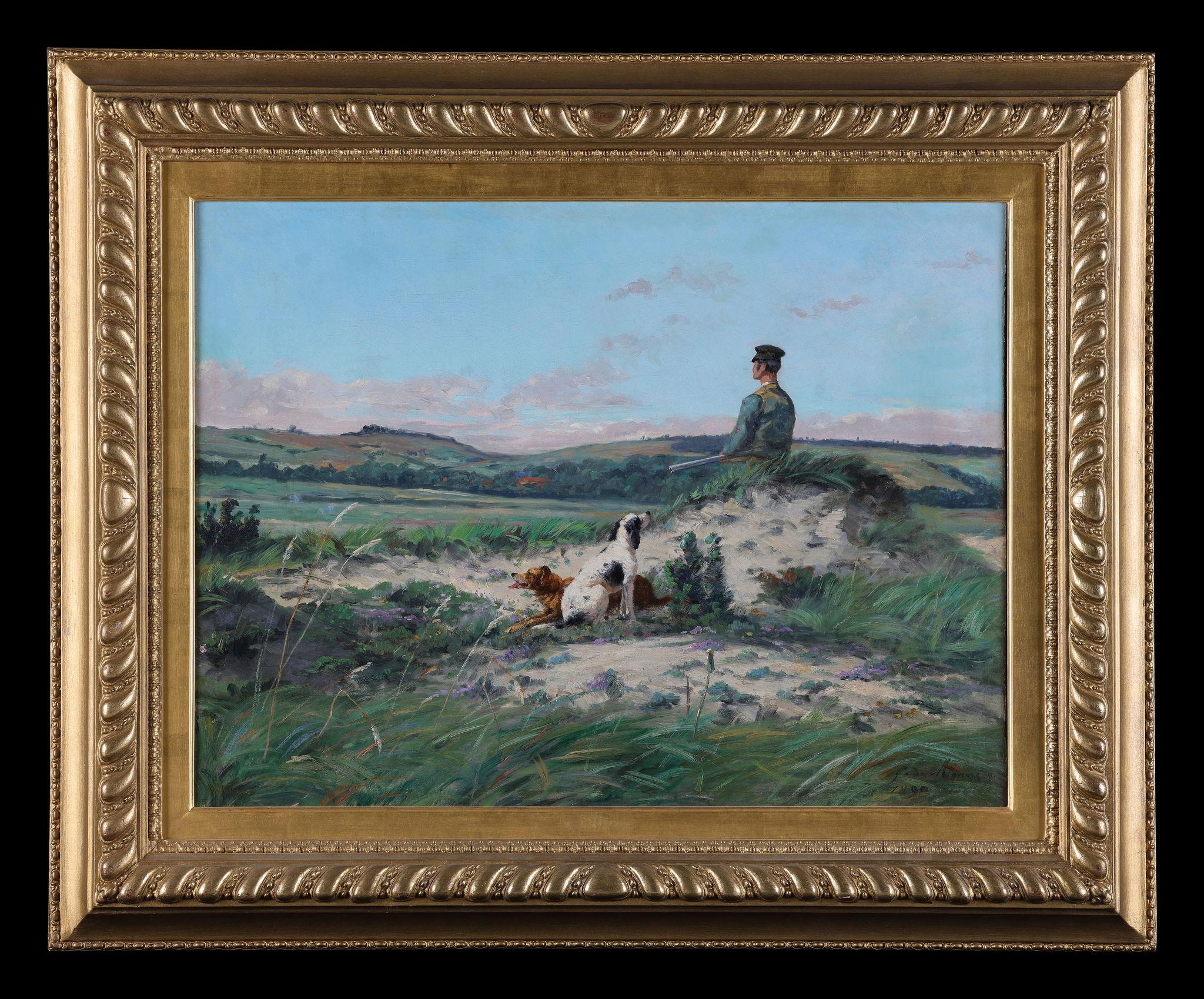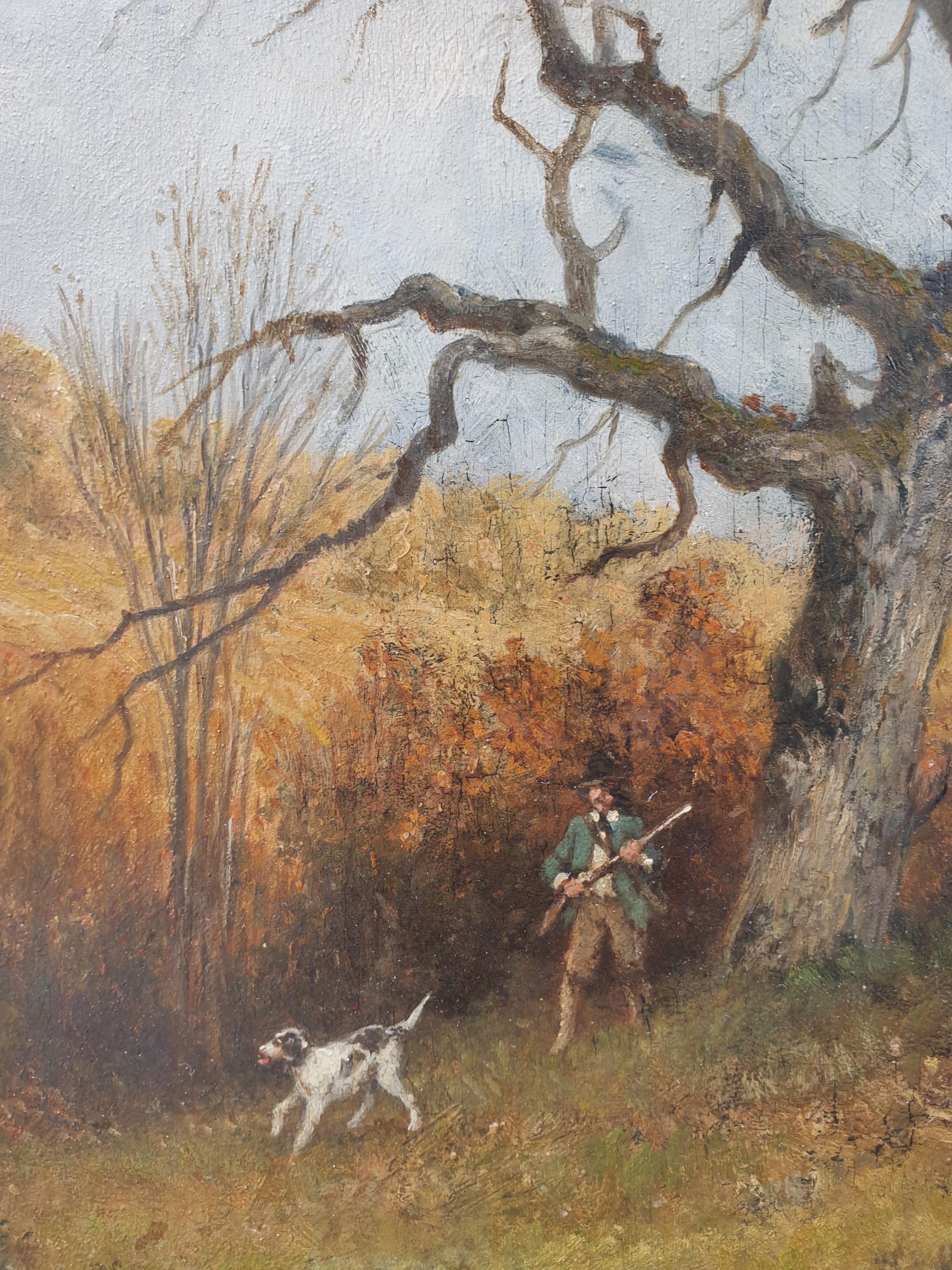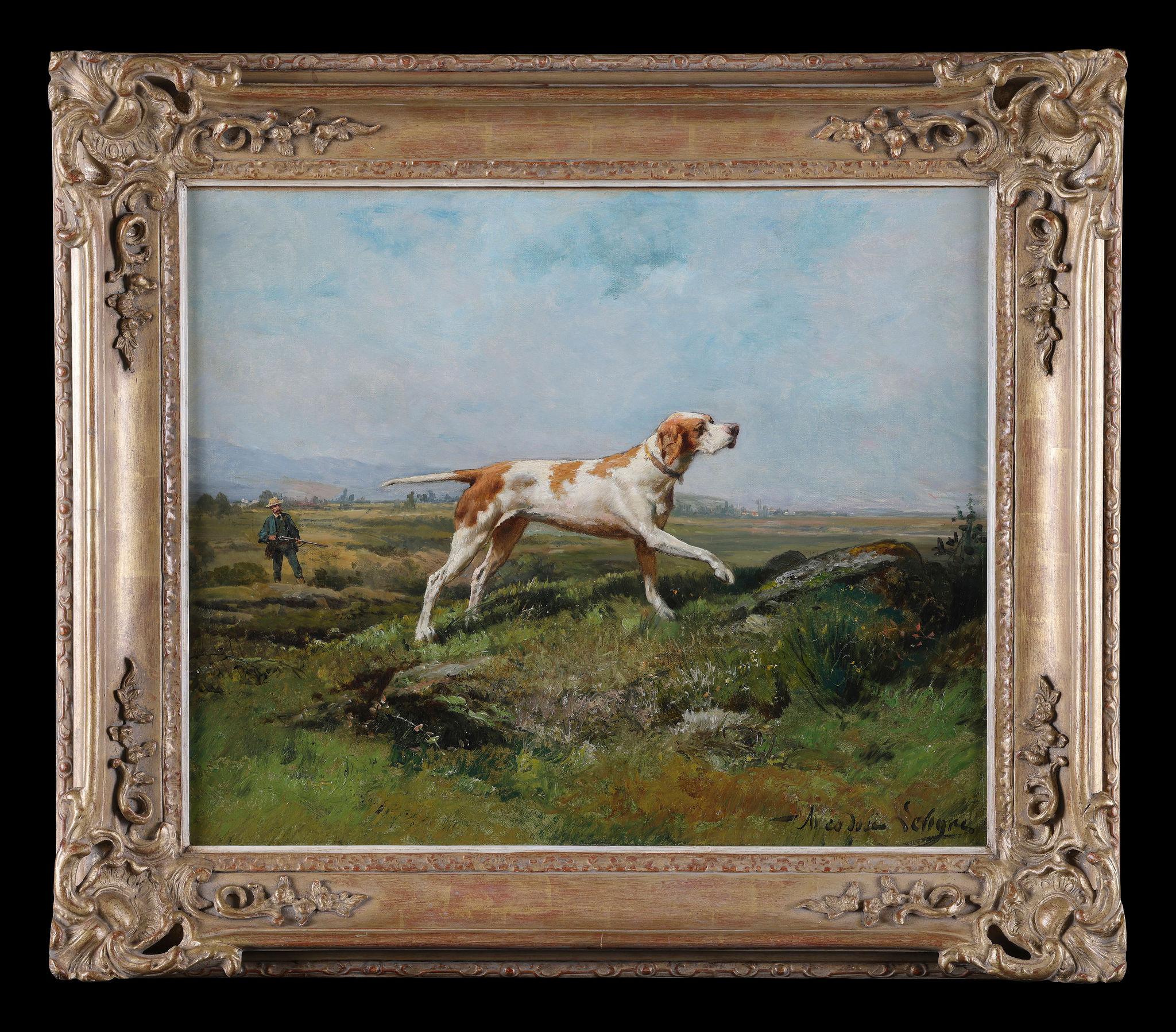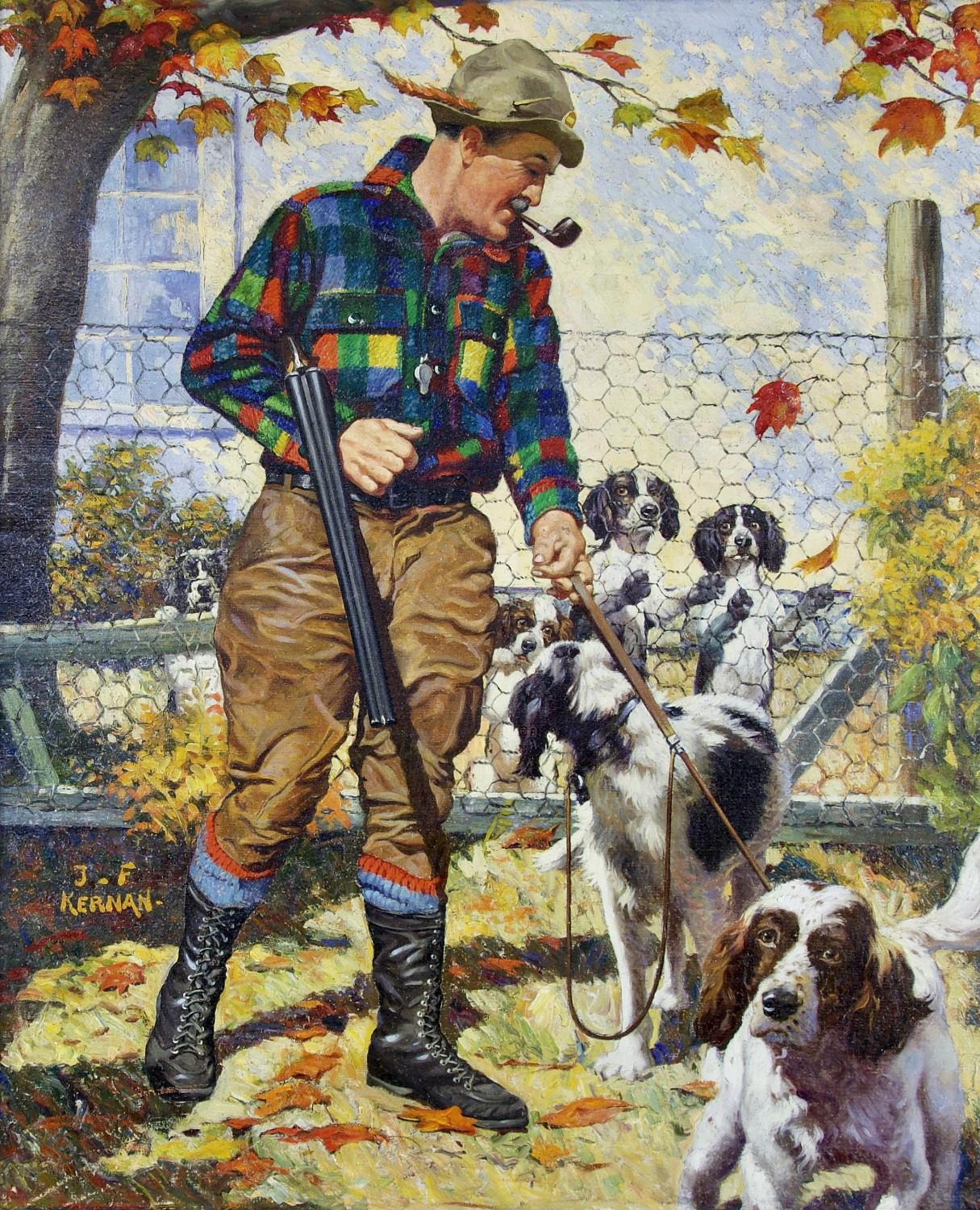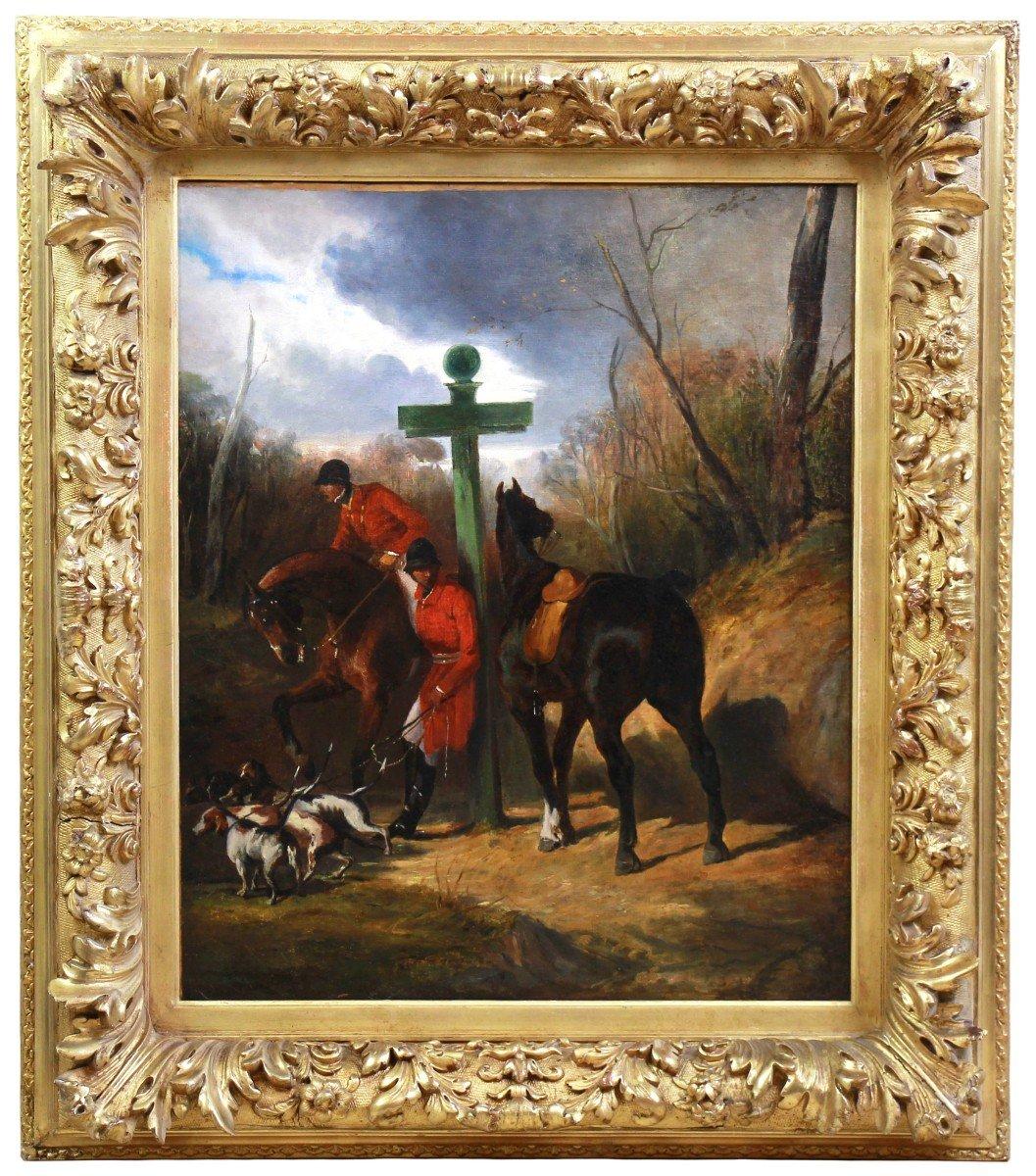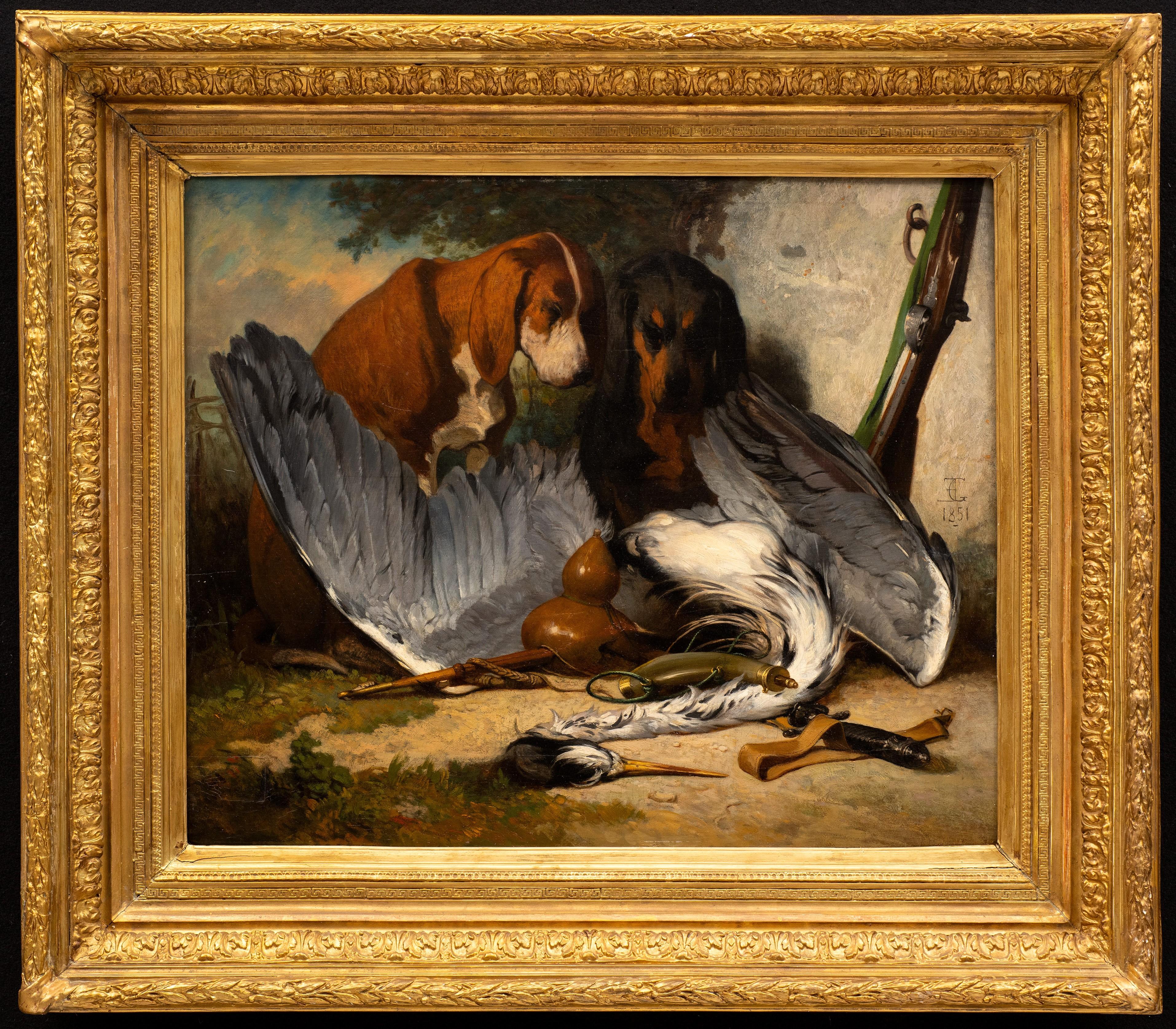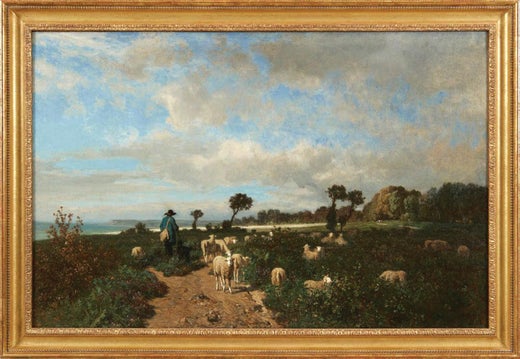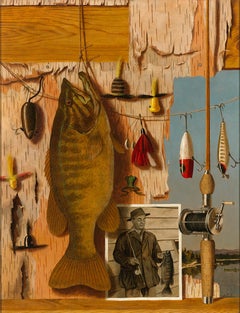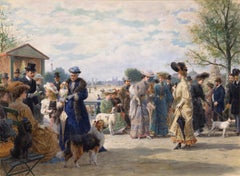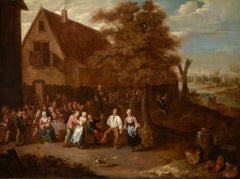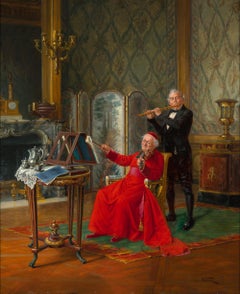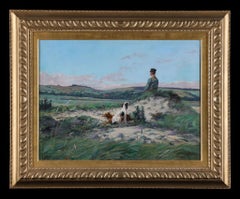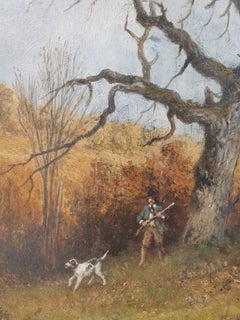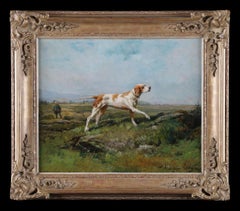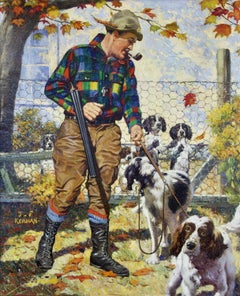Items Similar to The Gamekeeper and His Dogs by Constant Troyon
Want more images or videos?
Request additional images or videos from the seller
1 of 5
Constant TroyonThe Gamekeeper and His Dogs by Constant TroyonCirca 1850
Circa 1850
$128,500
£97,435.34
€112,536.70
CA$180,293.34
A$200,842.76
CHF 105,941.39
MX$2,435,280.60
NOK 1,347,727.28
SEK 1,255,493.32
DKK 840,355.31
About the Item
Constant Troyon
1810-1865 I French
The Gamekeeper and His Dogs
Oil on canvas
This remarkable composition, titled The Gamekeeper and His Dogs, is a masterwork by the celebrated Constant Troyon, one of the Barbizon School’s most accomplished artists and a leading figure in animal genre painting. Painted circa 1850, the work exemplifies Troyon’s exceptional talent. On a large scale, it depicts a weathered gamekeeper on a walk in the woods. He is clad in his signature blue coat and smoking a pipe, surrounded by his loyal canine companions. A white-and-brown spotted hound walks attentively, while a black, brown and white dog sniffs the ground nearby.
Troyon’s ability to capture the unique character and natural grace of each dog imbues the scene with life and charm, showcasing his unparalleled skill in portraying animals. The serene atmosphere of the rural landscape, coupled with the intimate connection between the gamekeeper and his dogs, reflects Troyon’s mastery in rendering both the tranquility of the countryside and the nuanced emotions of its inhabitants.
Born in 1810 to a Sèvres decorator, Troyon became known for his realistic and emotive portrayals of rural life and nature. By the mid-19th century, he had already achieved widespread acclaim, winning first-class medals at the Paris Salons in 1846 and 1848. A pivotal moment in Troyon’s career occurred in 1847 when he traveled to Holland and was deeply influenced by the works of the Dutch masters, particularly their skillful depictions of animals. This journey marked a turning point in his artistic focus, shifting his attention to animal subjects. His newfound inspiration led him to become one of Europe’s most prominent and sought-after painters, celebrated for his ability to capture the beauty and spirit of animals with exceptional realism.
Circa 1850
Literature:
Burlington Magazine, December 1910, pages 194, 195
Provenance:
Collection of Professor Fernand Gossens, Professor of Fine Arts, University of Brussels, Belgium, prior to 1921
Sold to the American Art Association, New York, February 3, 1921, Catalogue #68
Estate of Mrs. Vida L. W. Hudson (Mrs. Percy K. Hudson), Petersburg, VA
John Levy Galleries, New York
Purchased from M. R. Schweitzer Gallery, New York, July 6, 1984
Private collection, New York
M.S. Rau, New Orleans
- Creator:Constant Troyon (1810 - 1865, French)
- Creation Year:Circa 1850
- Dimensions:Height: 69.5 in (176.53 cm)Width: 51.28 in (130.26 cm)Depth: 3.25 in (8.26 cm)
- Medium:
- Movement & Style:
- Period:
- Condition:
- Gallery Location:New Orleans, LA
- Reference Number:Seller: 32-00191stDibs: LU18615477132
Constant Troyon
Constant Troyon (French, 1810 - 1865) was born August 28, 1810 in Sevres, France, where both of his parents were employed in The Sevres Porcelain Factory. He was trained by Riocreux, who was in charge of the porcelain museum at the factory, and worked as a painter on porcelain. He drew and painted from nature in his spare time. His work was featured in the Salon several times as he continued to work as a porcelain decorator. He painted with Jules Dupre in 1843, which was the same year he met Rousseau and went to work in Barbizon, where he received his academic training in landscape painting. He began to paint domestic animals in his work after a visit to Holland, where he was inspired by the work of Cuyp and Potter and became well-known for his animal paintings. He gained an international reputation with through many exhibitions of his work, which were held in collections abroad, and are now in the collections of the following famous museums: Louvre, Paris; Rijksmuseum, Amsterdam; Metropolitan Museum, New York; and Ermitage in Saint Petersburg. In his last years he painted seascapes on the Normandy coast, which was the same time Boudin worked for him. Constant Troyon died March 20, 1865 in Paris at the age of fifty-five.
About the Seller
5.0
Vetted Professional Seller
Every seller passes strict standards for authenticity and reliability
Established in 1912
1stDibs seller since 2013
17 sales on 1stDibs
Typical response time: 10 hours
- ShippingRetrieving quote...Shipping from: New Orleans, LA
- Return Policy
Authenticity Guarantee
In the unlikely event there’s an issue with an item’s authenticity, contact us within 1 year for a full refund. DetailsMoney-Back Guarantee
If your item is not as described, is damaged in transit, or does not arrive, contact us within 7 days for a full refund. Details24-Hour Cancellation
You have a 24-hour grace period in which to reconsider your purchase, with no questions asked.Vetted Professional Sellers
Our world-class sellers must adhere to strict standards for service and quality, maintaining the integrity of our listings.Price-Match Guarantee
If you find that a seller listed the same item for a lower price elsewhere, we’ll match it.Trusted Global Delivery
Our best-in-class carrier network provides specialized shipping options worldwide, including custom delivery.More From This Seller
View AllThe Bass Season by John Atherton
Located in New Orleans, LA
John Atherton
1900-1952 American
The Bass Season
Saturday Evening Post cover, June 29, 1946
Signed "Atherton" (lower right)
Inscribed "The Bass Season opens in the east July 1st /...
Category
20th Century American Modern Still-life Paintings
Materials
Canvas, Oil
Concours de Chiens au Promenade by Otto Eerelman
By Otto Eerelman
Located in New Orleans, LA
Otto Eerelman
1839-1926 Dutch
Concours de Chiens au Promenade
Watercolor on paper
Signed “O. Eerelman 1904” (lower left)
A tour de force watercolor by celebrated Dutch artist Otto Eerelman, one of 19th-century Europe's most popular and important animal portraitists, this charming composition captures a bustling cross-section of fashionable elites walking their equally fashionable canine companions. Eerleman takes care to render the detailed attire of his subjects, complete with plumed hats and layers of lace trim. The artist paints the plethora of pets in equally painstaking detail, capturing the nuances of each different breed represented.
Eerelman mastered the art of depicting not only the dogs’ physical characteristics but also their unique expressions and personalities. His wealthy clientele would bring their pets to his home in The Hague where they would live for a period of time while having their portraits done, allowing for a remarkably true-to-life portrayal. This energetic watercolor, with its profusion of color and texture, harnesses the affluence of its subjects and the leisurely whimsy of their luxurious lives.
Hailing from Groningen, Netherlands, Eerelman was dubbed the “Northern Rembrandt” during his lifetime. He received his artistic training at the Academy Minerva in Groningen, the Royal Academy of Fine Arts in Antwerp and then private lessons in the studio of the great Lawrence Alma Tadema. He successfully captured the attention of the Dutch court, particularly Princess Wilhelmina...
Category
Early 20th Century Post-Impressionist Figurative Drawings and Watercolors
Materials
Paper, Watercolor
A Peasant Country Scene by Jan Thomas van Kessel
Located in New Orleans, LA
Jan Thomas van Kessel
1677-1741 Flemish
A Peasant Country Scene
Signed (lower left)
Oil on canvas
A quintessential example of Flemish genre painting, A Peasant Country Scene refl...
Category
18th Century Old Masters Landscape Paintings
Materials
Oil
The Musician
Located in New Orleans, LA
Alfred Weber
1859-1922 I Swiss
The Musician
Signed “Alfred Weber” (lower left)
Oil on panel
This work by Swiss ecclesiastical genre painter Alfred Weber, best known for his humorous and meticulously detailed paintings, features a cardinal enjoying his leisure time. Weber's talent for rendering opulent interiors and his keen sense of comic narrative are evident in this painting. The cardinal, looking blissfully content, sits in his lavish living space playing the violin, accompanied by a flutist.
Alfred Charles Weber...
Category
Late 19th Century Academic Figurative Paintings
Materials
Oil, Panel
Newfoundland with a Kitten by Otto Eerelman
By Otto Eerelman
Located in New Orleans, LA
Otto Eerelman
1839-1926 Dutch
Newfoundland with a Kitten
Oil on canvas
Signed “O. Eerelman” (lower right)
This monumental painting is by the celebrated Dutch artist Otto Eerelman...
Category
Late 19th Century Academic Animal Paintings
Materials
Canvas, Oil
The Chess Game By Georges Croegaert
By Georges Croegaert
Located in New Orleans, LA
Georges Croegaert
1848-1923 Belgian
The Chess Game
Signed "Georges Croegaert Paris" (lower right)
Oil on panel
This oil on panel by Belgian artist Georges Croegaert is a rich and...
Category
19th Century Academic Figurative Paintings
Materials
Oil, Panel
You May Also Like
A Hunter with his Dogs
Located in St. Albans, GB
Gaston Le Sargeant De MONNECOVE
Oil on Canvas
Picture Size : 18 x 24" (46 x 61cm)
Outside Frame Size: 26 x 32" (66 x 81cm)
A classic example of De Monnecove's work capturing French hunting art...
Category
1890s French School Landscape Paintings
Materials
Oil
RENIE Barbizon Hunter Hound Hunt French Impressionnist 19th
By Nicolas Renie
Located in PARIS, FR
Nicolas RENIE
(Active 1840s to 1870s)
Oil on wood
33 x 24 cm (44.5 x 34 cm with frame)
Signed and dated lower left 'NRenié / 1879"
Nicolas Renié is part of the family of the Barbizo...
Category
1870s Impressionist Landscape Paintings
Materials
Oil
A Huntsman and a Pointer Dog. Oil painting on canvas
By Theodore Levigne
Located in St. Albans, GB
Theodore LEVIGNE
Oil on Canvas
Picture Size: 20 x 24" (51 x 61cm)
Outside Frame Size: 27 x 31" (67 x 77cm)
Born in 1848 and died in 1912 in Lyon, France
Painter of figures, portrait...
Category
Late 19th Century Barbizon School Animal Paintings
Materials
Oil
Hunter and His Dogs
By Joseph Francis Kernan
Located in Fort Washington, PA
Framed, dimensions: 45 x 39 in.
Signed lower left
Category
20th Century Figurative Paintings
Materials
Canvas, Oil
Oil on canvas “hunting scene with dogs” circle of Alfred De Dreux 19th century
By Alfred de Dreux
Located in Gavere, BE
Two hunters, one leaning against the cross and dogs on the left "halt in the forest"
Oil on canvas, restored and cleaned in good condition.
Very nice painting for hunting scene art...
Category
1850s French School Animal Paintings
Materials
Gold Leaf
"Still Life and Hunting Dogs, 1851" P. M. Guillemin (French, 1800-1874)
Located in SANTA FE, NM
"Still Life and Hunting Dogs, 1851"
P. M. Guillemin (French, 1800-1874)
Monogrammed "EG" on right side.
Oil on cradle board
26 x 21 (36 x 31 frame) inches
Stunning example and un...
Category
1850s Romantic Animal Paintings
Materials
Oil, Wood Panel
Read More
Paul Revere Crafted This Silver Coffee Pot 250 Years Ago
Perhaps best known as a Revolutionary War hero, Revere was also an accomplished silversmith, and this pot is now available on 1stDibs.
Degas Portrayed These Exuberant Ukrainian Dancers with ‘Orgies of Color’
Discovered in Parisian cabarets, the performers reenergized the artist’s practice.
More Ways To Browse
Large 19th Century Dog Painting
Dog Dutch Painting
Rau Antique
Oil Paintings By Percy
Hound Dog Framed Oil Painting
Innocent Nude
Seville Oil Painting
Antonio Giuseppe
Framed Rabbi
Kerala Art
Mouse Oil Painting
Outdoor Nude
Painting Of Courtship
Woman In Red Hat
Absolut Vodka
Marine Corps
Orientalist Egypt Paintings
St John The Baptist
